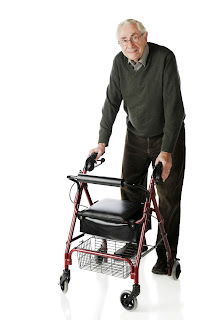Raleigh (my
miniature schnauzer that I profiled in my first Post) and I were taking our
afternoon walk when I recognized a familiar sound in the driveway near a house
we had just passed. It was the
grating of metal on concrete accompanied with a clatter of rocking wheels.
Turning to look back, I was not surprised to see an older man using an aluminum
mobility walker. He was
pushing it clumsily and incorrectly.
The sound was the legs scraping across the pavement.
The man looked
frightened and moved timidly. The lightweight walker barely supported him. He
shuffled his feet as if he didn’t trust it to prevent him from falling. He wasn’t using it correctly –picking
the walker up and placing it a short distance ahead of him, then walking into
it; he instead shoved it forward as he walked with it. I recognized the walker as the generic
brand I had seen a hundred times before. l guessed that it was donated,
purchased on line, or acquired secondhand, and I suspected that he had not
received professional training on how to use it.
Walkers are a
way of life in a senior community, and without them, residents would be more
apt to fall and injure themselves. According to the Center for Disease Control,
one out of three age 65 or older falls each year, and among the oldest segment
of that group, falls are the leading cause of injury death. Therefore, those with weak legs and
uncertain balance depend on sturdy, properly adjusted walkers to retain their
independence and mobility; few people realize that a walker has to be sized and
adjusted, just like a pair of corrective shoes, if it is to be effective.
I recall a
resident, Frank, who attached himself to me as his literary mentor. He fancied that he was a poet, and
every day he banged on my office door with a new creation for me to
critique. He was a small, thin
man, somewhat frail, and he had recently fallen on two occasions. His fear of a broken limb or displaced
hip had prompted him to became attached to a walker that he had inherited from
a former roommate, and he used it faithfully even for short distances.
Frank was
unaware that his walker wasn’t properly adjusted. The railings on the walker were set so low that he was
looking at his feet when he walked, and because he couldn’t see where he was
going, he often scraped furniture or ran into people. He had a bad habit of pushing the walker forward and
rambling with it. No one had ever trained him to place it ahead of himself and
then walk into it to catch up. To make matters worse, he had attached two lime
green tennis balls to the feet.
Temporarily, the balls made the walker’s feet slide easier, but after
prolonged use, the bottom of the balls will wear away leaving the metal exposed
to the floor. The metal becomes slippery and once weight is applied, the legs
will slide like skates on ice.
I pointed out
Frank’s problem to Lisa, our physical therapist. She called his doctor asking
for an order for Frank to receive training. She discovered that Frank was
eligible for a new walker from Medicare, and she arranged to have a shiny new
one delivered to him within days.
She adjusted the height so that he would stand more erect, and
encouraged him to: “Pick up the frame, place it ahead of yourself, walk into
the frame and repeat”. Finally,
she attached the specially designed slides on the legs to facilitate propelling
a walker smoothly, and she discouraged him from exchanging them for the lime
green tennis balls.
After his
training, Frank still came to my office every day. In fact, he felt so good about himself he often came twice a
day. He was more mobile and more self confident, and he appeared stronger and
happier

No comments:
Post a Comment